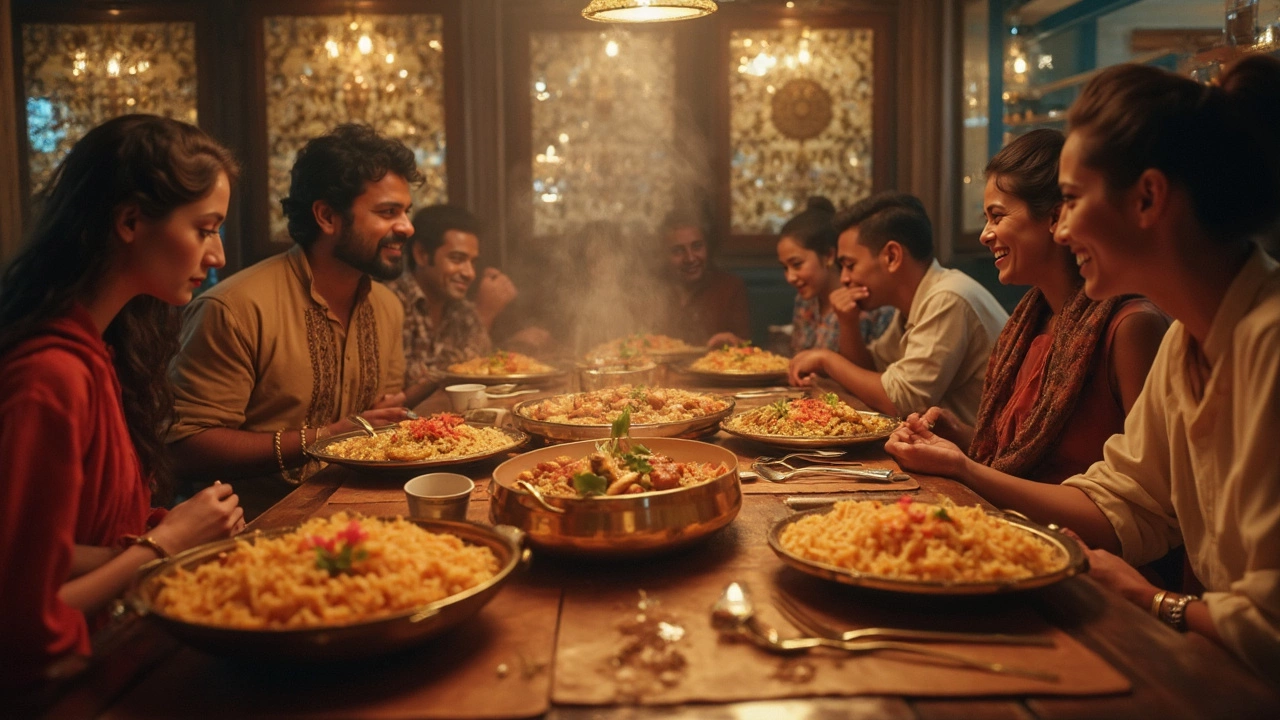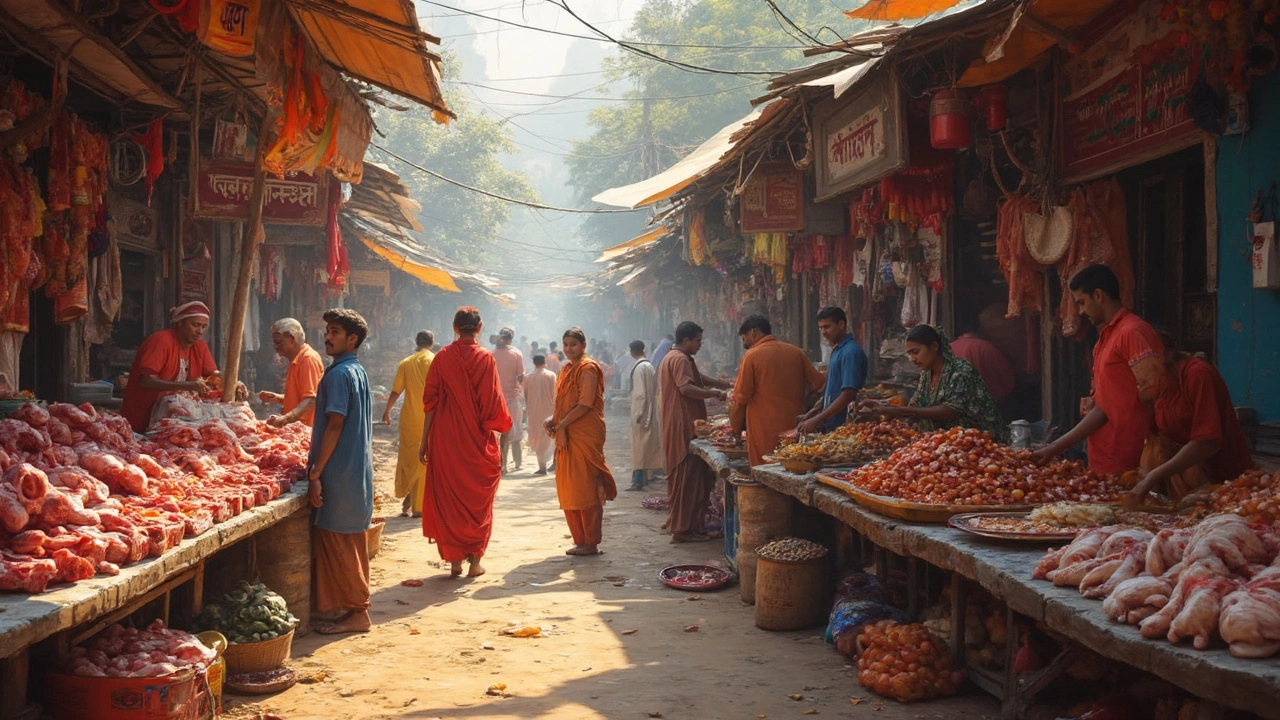Walk through any busy Indian market, and you'll spot something clear—chicken is king. If you're traveling around, most locals will offer you chicken when they hear you want to try some classic Indian dishes. It's affordable, easy to cook in a thousand ways, and works for most dietary rules. In major cities, even fast food chains like KFC and McDonald's sell chicken burgers and nuggets by the bucketload, tuned to local flavors (spicy, of course).
But don't assume it's the same across every corner of the country. Head to Tamil Nadu, West Bengal, or Kerala, and you might see more variety, like mutton curries or seafood grills. Still, when you ask restaurant owners or street food vendors what gets ordered most, chicken dishes like tandoori, curry, or biryani win almost everywhere. If you want to try what most Indians eat out, start with chicken—and ask for local twists in the seasoning. You won't regret it.
- Chicken: India's Go-To Meat
- Busting Myths: Beef, Pork, and Mutton on the Menu
- Religious Beliefs Shaping Meat Choices
- Tips for Food-Loving Travelers in India
Chicken: India's Go-To Meat
When you think of eating meat in India, chicken is what you'll see the most. Out of all meat eaters, about 80% say chicken is their first choice. Around 3.5 million metric tons of chicken are consumed every year in India—that's almost double the amount eaten just 10 years ago. Chicken fits easily into both North and South Indian plates whether it’s a party platter or daily home food.
One big reason for chicken’s popularity is religion. Unlike beef, which most Hindus avoid, and pork, which most Muslims skip, chicken works for almost everyone. It’s cheaper than lamb or mutton, which means you find chicken dishes on every street and in every restaurant, from five-star buffets to family-run dhabas on highways.
| Meat Type | Annual Consumption (2024, million metric tons) |
|---|---|
| Chicken | 3.5 |
| Mutton/Lamb | 0.5 |
| Beef | 1.7* |
| Pork | 0.1 |
*Mostly in certain states; banned in many parts of India.
Chicken takes the spotlight at every big celebration too—weddings, Diwali, birthdays. Dishes like butter chicken, tandoori chicken, chicken biryani, and chicken 65 (from South India) are all local legends. Even vegetarians who eat eggs, called 'eggetarians,' will sometimes switch to chicken at big feasts.
If you want to eat like a local, order any chicken dish with roti or rice. Restaurants everywhere, including tourist spots, offer special deals on chicken-based meals. Just a tip—ask how spicy the dish is before you order, because Indian chicken curries mean business when it comes to chili!
Want to snap a cool food photo for your feed? Indian chicken recipes are colorful and loaded with garnish, making them pop on camera. If you care about health, grilled versions like tandoori chicken are a lot leaner compared to fried ones. So yes, chicken consumption in India is more than just common—it's the national standard for non-veg food lovers.
Busting Myths: Beef, Pork, and Mutton on the Menu
If you’re thinking everyone in India avoids beef, pork, or mutton, that isn’t totally true. The real story is a bit more layered, and it’s tied to culture, religion, and even government rules.
Beef is one of the most talked about meats when it comes to meat in India. Hindu communities usually avoid it since cows are considered sacred, but Christian and Muslim communities, especially in Kerala, Goa, and pockets of the Northeast, still eat it. That said, about 22 states have strong bans or strict limits on beef, so don’t expect beef burgers to pop up on every corner.
Pork’s popularity swings wildly depending on where you are. In the northeastern states like Nagaland or Mizoram, and among Goan Catholics and some tribal groups, pork is totally normal. But in places with big Muslim communities, you won’t find it much, since eating pork is against Islamic rules. It’s a niche option but nowhere near as visible as chicken even in those places.
Mutton in India usually means goat, not sheep. This one’s pretty universal, but it does cost more, so not everyone eats it regularly. When there’s a festival or a party, though, mutton biryani or curry is often the star dish. In fact, lamb or goat meat is way more common than lamb in the West.
Here’s a quick look at how much these meats are actually consumed in India each year:
| Meat Type | Estimated Annual Consumption (thousand tons, 2023) |
|---|---|
| Chicken | 4,500 |
| Mutton/Goat | 700 |
| Beef (including buffalo meat) | 2,000 |
| Pork | 300 |
If you want to try these meats, scan the menu carefully or ask the waiter—what’s allowed in one city might be banned in another, and religious traditions shape a lot of local food habits. For food travelers: try local favorites, be open to asking questions, and don’t expect the same menu in every part of the country. Honestly, that’s half the adventure!

Religious Beliefs Shaping Meat Choices
Eating habits in India aren't just about taste—they’re rooted in religion, tradition, and family rules. Hinduism, which is the majority faith, usually avoids beef, as cows are considered sacred. If you’re eyeing a beef burger in most Indian cities, good luck—beef is banned or restricted in many states.
Muslim communities, which make up a big part of the population, don’t eat pork, but often enjoy chicken, mutton (goat meat), and sometimes beef where it’s legal. Muslims follow halal guidelines, so you’ll spot plenty of halal signs at meat shops and restaurants, especially in big cities.
India’s Christian minorities have fewer restrictions, so you’ll find more pork and beef on menus in places like Goa and Kerala. Meanwhile, Sikhs, especially practicing ones, usually skip halal or kosher meat due to their own religious rules but have no issue with chicken, mutton, or fish.
Then there’s the huge wave of vegetarians—one of the highest numbers anywhere in the world—mostly for religious reasons. Jainism takes it a step further, avoiding not just meat, but also root vegetables like onions and garlic. When exploring Indian food culture, always check the menu, ask questions, or go with a local. Religious rules really shape what’s on offer, and knowing this helps you order like a pro.
Tips for Food-Loving Travelers in India
First things first, you don't have to be a hardcore meat eater to enjoy Indian cuisine. But if you're curious about meat in India or just want to eat what the locals eat, here are some tips you really don't want to miss.
- Stick to busy spots for meat: Crowded restaurants and food stalls move their ingredients fast, so your food is fresher. Locals know which places are legit, so join the line or ask people around.
- Don't assume beef or pork is on the menu: Most Indians, especially Hindus and some groups of Muslims, avoid beef and pork. Chicken and mutton (often goat) are your safest bets pretty much everywhere except Goa and Kerala, where pork or beef might show up due to local Christian or Muslim communities.
- Always check if it's halal: In big cities like Delhi, Kolkata, Hyderabad, and Mumbai, halal meat is pretty standard in Muslim-run eateries. If this matters to you, ask before you order.
- Go for regional favorites: Each region has a meat dish that's a total hit. Try "chicken tikka" in north India, "chettinad chicken" in Tamil Nadu, or "Kolkata biryani" if you're in West Bengal.
- Watch your spice level: Indian curries can go from mild to volcanic. Say "less spicy" if you’re not used to fire in your food—even locals sometimes ask for it!
Here’s a quick cheat sheet of the most popular meats in different parts of India:
| Region | Most Popular Meat | Iconic Dish |
|---|---|---|
| North India (Delhi, Punjab, UP) | Chicken, Mutton | Tandoori Chicken, Rogan Josh |
| South India (Tamil Nadu, Kerala) | Chicken, Fish | Chettinad Chicken, Kerala Fish Curry |
| West India (Goa, Maharashtra) | Pork, Chicken | Goan Pork Vindaloo, Chicken Sukka |
| East India (West Bengal, Assam) | Fish, Chicken | Kolkata Biryani, Fish Curry |
And for a few numbers: According to India's National Sample Survey Office in 2023, about 71% of Indians identify as non-vegetarian, but most eat meat just a few times a month. Chicken leads the pack—its consumption shot up by 32% over the last decade. So if you want to blend in, order chicken. But if you’re feeling brave, try a mutton curry at a local dhaba. It's the move for true food explorers.
